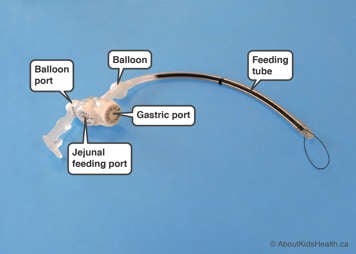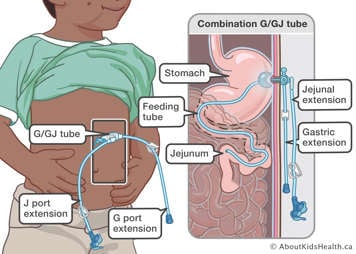What is a low-profile combination G/GJ tube?
A low-profile combination gastrostomy/gastrojejunostomy (G/GJ) tube is a type of feeding tube that provides fluids, nutrition and medications directly into the small intestine (jejunum) through the jejunal feeding port. There is a second port that gives access to the stomach for venting and a third port for balloon inflation. The balloon keeps the low-profile combination G/GJ tube in place. It is called "low-profile" because it sits close to the skin and is very discreet. Low-profile combination G/GJ tubes are placed by an interventional radiologist using image guidance.
The low-profile combination G/GJ tube is placed through an opening in your child's abdomen called a stoma. The tunnel from the outside through the stoma is called the tract.

The port labelled "Gastric" on the side of the tube, is used to access the stomach. This port is usually used for venting.
The port labelled "Jejunal", on the top of the tube, is used to access the small intestine. This port is usually used for feeding, medications and fluids.
Inside both ports is a one-way valve. This valve helps prevent stomach and jejunal content from flowing back out through the tube.

A low-profile combination G/GJ tube is not used for primary tube insertion. This means that your child will have a different type of feeding tube first and may then transition to a low-profile combination G/GJ tube after a few months.
| The SickKids G-Tube Feeding Program has developed a one page guide to help you quickly troubleshoot any issues with your child's feeding tube: G-Tube Feeding Program Family One Pager |
How is a combination G/GJ tube different from other types of tubes?
Low-profile combination G/GJ tubes are different than surgically inserted J tubes. While both tubes are inserted into the small intestine, the low-profile combination G/GJ tube enters through your child's stomach, passes through into the first part of the small intestine and ends in the jejunum. Surgical J tubes are inserted directly into the jejunum by a surgeon in an operating room.
The low-profile combination G/GJ tube is also different from a low-profile GJ tube. Both types of feeding tube provide fluids, nutrition and medication directly into the small intestine, however the combination G/GJ tube has a gastric port through which gas can be vented from the stomach, while the low-profile GJ tube does not.
The G tube team provides support related to both low-profile combination G/GJ tubes, low-profile GJ tubes and surgical J tubes after insertion.
Giving feeds, liquids and medication through the low-profile combination G/GJ tube
Your child's tube feeds are to remain the same as with previous GJ or combination G/GJ tube exchanges.
A Mic-Key low-profile combination G/GJ tube extension set needs to be attached to the jejunal feeding port to administer feeds and medications. As well, an extension set needs to be attached to the gastric port to vent the stomach. Both extension sets can be connected at the same time to allow you to vent the stomach during feeds. A slip-tip syringe can be attached directly to either port; however, this is not recommended as the one-way valve can break with frequent access by syringes.
For more information on connecting and removing the extension sets, please see the article "How to use a feeding extension set for a low-profile balloon G tube”.
Caring for your child's low-profile combination G/GJ tube
The balloon port of your child's low-profile combination G/GJ tube helps to keep the tube from accidentally being pulled out.
| Internal tube length | Balloon volume minimum | Balloon volume maximum |
|---|---|---|
| 15 cm, 22 cm, and 30 cm | 3 mL | 5 mL |
| 45 cm | 5 mL | 10 mL |
Here are some things to remember when caring for your child's low-profile combination G/GJ tube:
- Do not feed your child through the balloon port
- Do not fill the balloon with saline solution or air
- Filling the balloon with more or less sterile or distilled water can affect the position of the tube
The doctor who inserts the tube may fill the balloon with less than the recommended balloon volume. If this is the case, you will need guidance from your health-care team before you increase the balloon volume.
Filling the balloon with more or less sterile or distilled water can affect the fit of the tube against the skin. Less water in the balloon makes the tube sit looser and stick out from the skin. More water in the balloon makes the tube sit tighter and closer to the skin. If the tube is so tight you can see an indent in your child’s skin, you can decrease the amount of water in the balloon. If the tube sticks out too much and is dangling from the stoma, you can increase the amount of water in the balloon. If adjusting the balloon volume does not help with the fit of your child’s tube, you may need to have the tract re-measured by your G tube specialist.
For more information on checking the volume of water in the balloon and assessing the fit of your child’s tube, please see the article “Checking the balloon on a feeding tube”.
Skin care
Keep the stoma and surrounding skin as dry and clean as possible. Dressings and tape are not needed with a low-profile combination G/GJ tube.
Despite your best effort to keep your child's skin around the stoma healthy, some common skin problems may occur including:
What to do if your child's tube is accidentally pulled out or migrates into the stomach
What to do if your child's tube is accidentally pulled out
Although it is very unlikely, your child's low-profile combination G/GJ tube may be accidentally pulled out. It is important to insert a Foley type tube into the tract as soon as possible to prevent the stoma and tract from closing. The sooner you insert the Foley catheter, the easier it will be to insert. You will need to carry the Foley catheter and emergency supplies with you at all times in case the tube is accidentally pulled out.
Most children with a G/GJ tube cannot feed into their stomach. However, some can. Speak to your child’s health-care provider to discuss whether this is safe for your child.
For full instructions on what to do if your child's tube is accidentally pulled out, please see the article "What to do if your child's feeding tube is pulled out".
If the tube has moved into the stomach
If the low-profile combination G/GJ tube has moved out of the small intestine and into the stomach, your child may experience:
- increased vomiting
- vomiting formula
- gagging and retching
- abdominal discomfort or pain
- bloated stomach
- diarrhea
- leaking of formula from the gastric port or stoma
The position of the tip of the combination G/GJ tube will need to be confirmed by an interventional radiologist using image guidance. Do not use the tube for feeding until the tube position is confirmed.
For more information on what to do if the tube has moved, please see the article “What to do if your child’s feeding tube moves”.
Intussusception
Intussusception may occur around the tube. Intussusception is when one part of the small bowel slides into the next part. This can happen at the tip of the combination G/GJ tube. Large combination G/GJ tubes and/or normal movements of the bowels may cause intussusception.
A child with intussusception will experience:
- discomfort and feeding intolerance (vomiting when fed)
- vomiting bile (green fluid)
- diarrhea or blood in the stool
If you think that your child’s tube has intussuscepted, contact their G tube specialist during business hours. After hours, on weekends or on holidays, take your child to the Emergency Department.
Replacing the low-profile combination G/GJ tube
G/GJ tubes are typically changed every four to six months. You will need to keep track of how long your child has had their tube and contact the G tube specialist to make an appointment for the tube exchange.
When to seek medical attention
Contact the G tube specialist if you notice any of the following signs and symptoms:
- Your child's stoma site appears infected. Signs of infection include redness, edema (swelling) and odorous discharge.
- There is granulation tissue, which is pink to bright red, bloody, raw, moist, oozing yellow sticky discharge and/or painful.
- The stoma site is leaking intestinal or stomach contents and/or formula.
- The gastric port is leaking stomach contents.
- The tube appears to be damaged, broken, or dislodged, but you can still use the tube.
Go to the nearest Emergency Department if you notice any of the following signs and symptoms:
- Your child experiences abdominal pain, distension, discomfort, vomiting and/or other signs of feeding intolerance.
- Your child has signs of respiratory distress (i.e.. higher breathing rate or difficulty breathing).
- The tube appears to be damaged, broken or dislodged, and you cannot use the tube.
At SickKids
If your child is a SickKids patient, contact the G Tube Resource Nurse with any concerns.
G Tube Resource Nurse contact info:
Phone 416-813-7177
g.tubenurse@sickkids.ca
On weekends/afterhours, you may need to come to the Emergency Department for an alternate method of feed/fluids/medication administration.
